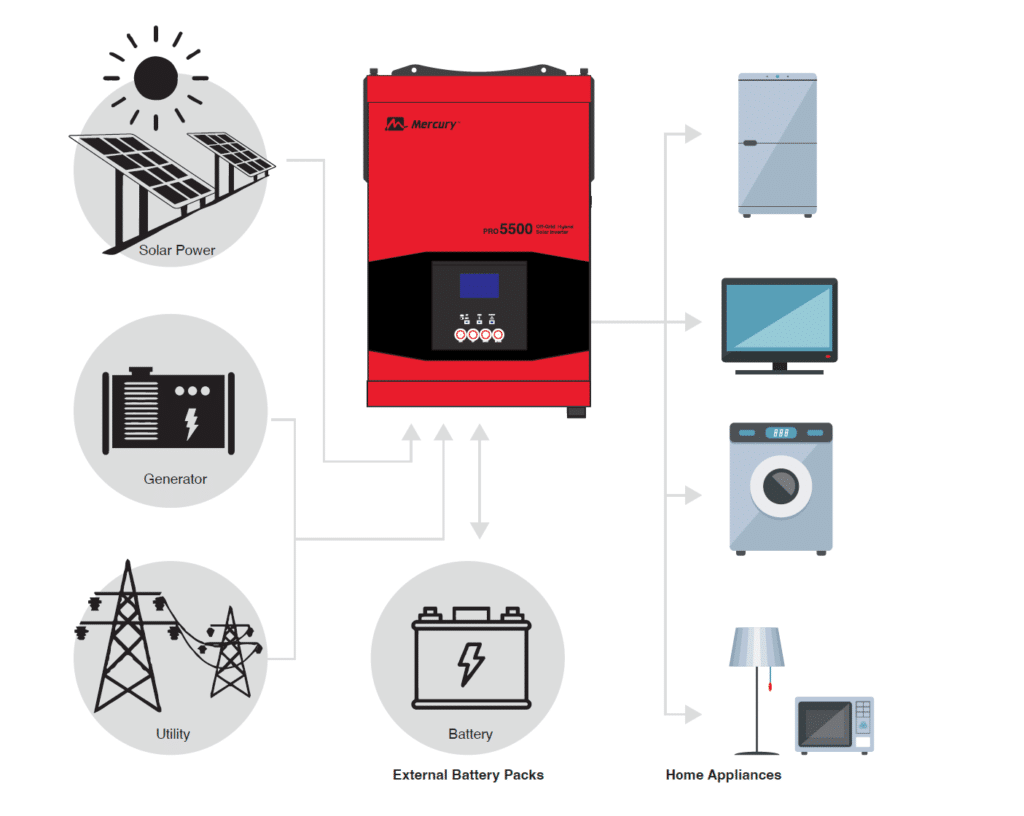As more people turn to renewable energy and backup power solutions, inverters have become an essential tool for ensuring a steady flow of electricity. However, a lot of inverter myths persist, leading to confusion and poor decision-making. This article aims to debunk common inverter myths and provide valuable insights that can help you optimize your energy use effectively and affordably.
What is an Inverter?
Before addressing specific inverter myths, it’s important to understand the basics. An inverter is a device that converts direct current (DC) from sources like solar panels or batteries into alternating current (AC), the type of electricity that powers most household appliances. Inverters are vital for systems that utilize renewable energy, off-grid setups, and backup power solutions. Understanding the types of inverters—modified sine wave inverters and pure sine wave inverters—is essential to optimizing your power setup.
Myth 1: You Can Power Your Whole House with a Solar Inverter

The Truth:
While it’s technically possible to power your entire home with a solar inverter, it’s not always practical. Large appliances like electric cookers, heat extractors, and air conditioners consume significant amounts of power. To run everything on solar inverters alone, you’d need a large and expensive system, with substantial solar panels and a high-capacity battery setup.
For most households, a hybrid system combining solar inverters with grid power or backup generators is more cost-effective. This allows you to make efficient use of solar energy without overburdening the inverter with heavy loads.
Why this Myth Exists:
Many people are drawn to the idea of complete energy independence, but they often overlook the high energy demand of large appliances, which can quickly overwhelm a solar inverter system.
Myth 2: Inverters Waste a Lot of Energy During Conversion
The Truth:
Many believe that inverters waste energy during the conversion process. However, modern inverters—especially pure sine wave inverters—are designed with efficiency in mind. Most inverters today convert over 90% of the energy they receive into usable power. While pure sine wave inverters offer cleaner energy for sensitive electronics, modified sine wave inverters are highly efficient and cost-effective for powering most household appliances with minimal energy loss.
Why this Myth Exists:
This myth stems from older, less efficient inverter models. Today’s technology has greatly improved efficiency, making inverters an energy-saving tool rather than an energy waster.
Myth 3: Inverters Are Too Expensive to Justify the Investment
The Truth:
While inverters can be expensive upfront, they are a smart long-term investment, particularly for homes that use renewable energy like solar power. Modified sine wave inverters are affordable and efficient, while pure sine wave inverters are often used for more sensitive electronics and come with a higher price tag.
However, the long-term savings from reduced energy bills and less reliance on the grid make inverters a financially sound choice over time.
Why this Myth Exists:
The high initial cost of buying and installing an inverter system can be intimidating, but many overlook the long-term financial benefits.
Myth 4: All Inverters Are the Same
The Truth:
Not all inverters are created equal, and this is a major inverter myth. There are different types of inverters tailored to different needs. Modified sine wave inverters are more affordable and are suitable for basic appliances like lights, fans, and refrigerators. However, pure sine wave inverters produce cleaner energy and are ideal for sensitive electronics like medical devices and computers.
Choosing the wrong inverter for your needs can lead to inefficiency, higher costs, or even damage to sensitive equipment. For most households, a modified sine wave inverter is a practical, cost-effective choice.
Why this Myth Exists:
Many assume that all inverters perform the same function, leading to confusion. In reality, there are significant differences in how various inverters handle different types of appliances.
Myth 5: Inverters Can Instantly Supply Unlimited Power from Solar Panels
The Truth:
A common misconception is that solar inverters can supply unlimited power as long as the sun is shining. However, inverters have limits on how much power they can handle at any given time. The amount of electricity your solar panels generate depends on sunlight availability, weather, and time of day. Additionally, without battery storage, your inverter can only supply power when the solar panels are actively generating electricity.
During periods of high demand or cloudy weather, solar panels may not produce enough energy to meet your household’s needs. Inverters work within these limitations to provide as much power as possible, but it’s important to understand their capacity.
Why this Myth Exists:
Many people equate having solar panels with unlimited power, not realizing that inverters and panels have output limits based on weather, time of day, and load.
Myth 6: Inverters Are Only Useful During Power Outages
The Truth:
Inverters are invaluable during power outages, but their role goes beyond emergency situations. They are essential for energy management, especially when paired with solar panels or battery storage systems. By storing excess solar energy during the day, inverters allow you to use it when grid power is expensive or unavailable.
For households looking to reduce energy bills and maximize the use of renewable energy, inverters are crucial tools in optimizing power usage throughout the day.
Why this Myth Exists:
Inverters are often marketed as backup power solutions, leading people to think their usefulness is limited to outages. In reality, inverters are a key part of daily energy management in solar and hybrid systems.
Conclusion: The Truth About Inverter Myths
Understanding the truth behind inverter myths helps homeowners and businesses make informed decisions about their energy systems. Inverters are critical for optimizing energy use, whether in a solar setup or a backup power solution.
By dispelling these common inverter myths, you can select the right system for your needs—whether it’s a modified sine wave inverter for basic appliances or a pure sine wave inverter for sensitive electronics.
FAQs
Can a solar inverter power my whole house?
While it’s possible, large appliances like electric stoves and water heaters consume too much energy, making it impractical without a high-capacity, expensive system.
Are modified sine wave inverters inefficient?
No, modified sine wave inverters are efficient for most household appliances, though pure sine wave inverters are better for sensitive electronics.
Do inverters waste a lot of energy?
Modern inverters are highly efficient, with most converting over 90% of input energy into usable power, including modified sine wave inverters.
Are all inverters the same?
No, modified sine wave inverters are ideal for basic appliances, while pure sine wave inverters are better for sensitive electronics.
Are inverters only useful during power outages?
No, inverters play a key role in energy management, especially in solar systems, by storing excess energy and optimizing its use throughout the day.
Are inverters too expensive to justify?
Although the upfront cost can be high, inverters offer long-term savings, particularly when paired with renewable energy sources like solar panels.


The blog was very informative and helpful I came across many new things. I hope you keep uploading more blogs.
I’m glad you liked the blog post! I’ll continue to maintain the quality and ensure the content remains valuable. If you have any specific topics or ideas on inverters, batteries, or solar panels that you’d like to see covered in future posts, feel free to share!
This is highly commendable. The information packed into this article is incredible.
Is it possible to use a higher capacity inverter like 3.5kva to run a far lower solar panel of 300 watts and one 200ah battery. I have that in inverter but want to provide solar power solution for my son in school. He uses only a ceiling fan, 2 laptops and 3 Android phone and 2 10watt bulbs.
Which one is more efficient, transformer based or non transformer based inverters.